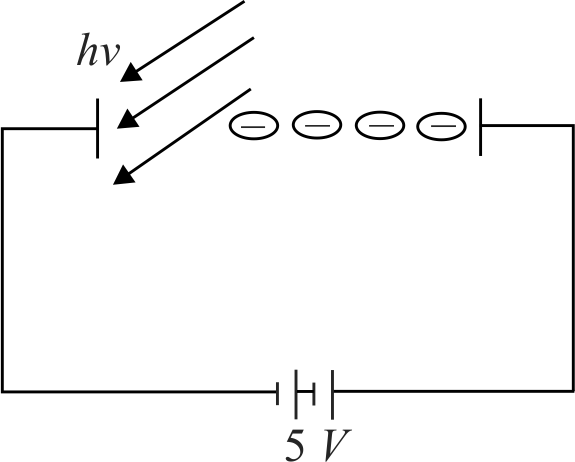357678 Photons with energy \(5\,eV\) are incident on a cathode \(C\) in a photoelectric cell. The maximum energy of emitted photoelectrons is \(2\,eV\). When photons of energy \(6\,eV\) are incident on \(C\), no photoelectrons will reach the anode \(A\), the stopping potential of \(A\) relative to \(C\) is
357679 When photons of energy hv fall on a metal plate of work function ' \(W_{0}\) ', photoelectrons of maximum kinetic energy \('K'\) are ejected. If the frequency of the radiation is doubled, the maximum kinetic energy of the ejected photo electrons will be
357680 Photoelectric emission is observed from a metallic surface for frequencies \(v_{1}\) and \(v_{2}\) of the incident light \(\left(v_{1}>v_{2}\right)\). If the maximum values of kinetic energy of the photoelectrons emitted in the two cases are in the ratio \(1: 2 n\), then the threshold frequency of the metallic surface is:
357678 Photons with energy \(5\,eV\) are incident on a cathode \(C\) in a photoelectric cell. The maximum energy of emitted photoelectrons is \(2\,eV\). When photons of energy \(6\,eV\) are incident on \(C\), no photoelectrons will reach the anode \(A\), the stopping potential of \(A\) relative to \(C\) is
357679 When photons of energy hv fall on a metal plate of work function ' \(W_{0}\) ', photoelectrons of maximum kinetic energy \('K'\) are ejected. If the frequency of the radiation is doubled, the maximum kinetic energy of the ejected photo electrons will be
357680 Photoelectric emission is observed from a metallic surface for frequencies \(v_{1}\) and \(v_{2}\) of the incident light \(\left(v_{1}>v_{2}\right)\). If the maximum values of kinetic energy of the photoelectrons emitted in the two cases are in the ratio \(1: 2 n\), then the threshold frequency of the metallic surface is:
357678 Photons with energy \(5\,eV\) are incident on a cathode \(C\) in a photoelectric cell. The maximum energy of emitted photoelectrons is \(2\,eV\). When photons of energy \(6\,eV\) are incident on \(C\), no photoelectrons will reach the anode \(A\), the stopping potential of \(A\) relative to \(C\) is
357679 When photons of energy hv fall on a metal plate of work function ' \(W_{0}\) ', photoelectrons of maximum kinetic energy \('K'\) are ejected. If the frequency of the radiation is doubled, the maximum kinetic energy of the ejected photo electrons will be
357680 Photoelectric emission is observed from a metallic surface for frequencies \(v_{1}\) and \(v_{2}\) of the incident light \(\left(v_{1}>v_{2}\right)\). If the maximum values of kinetic energy of the photoelectrons emitted in the two cases are in the ratio \(1: 2 n\), then the threshold frequency of the metallic surface is:
357678 Photons with energy \(5\,eV\) are incident on a cathode \(C\) in a photoelectric cell. The maximum energy of emitted photoelectrons is \(2\,eV\). When photons of energy \(6\,eV\) are incident on \(C\), no photoelectrons will reach the anode \(A\), the stopping potential of \(A\) relative to \(C\) is
357679 When photons of energy hv fall on a metal plate of work function ' \(W_{0}\) ', photoelectrons of maximum kinetic energy \('K'\) are ejected. If the frequency of the radiation is doubled, the maximum kinetic energy of the ejected photo electrons will be
357680 Photoelectric emission is observed from a metallic surface for frequencies \(v_{1}\) and \(v_{2}\) of the incident light \(\left(v_{1}>v_{2}\right)\). If the maximum values of kinetic energy of the photoelectrons emitted in the two cases are in the ratio \(1: 2 n\), then the threshold frequency of the metallic surface is:
357678 Photons with energy \(5\,eV\) are incident on a cathode \(C\) in a photoelectric cell. The maximum energy of emitted photoelectrons is \(2\,eV\). When photons of energy \(6\,eV\) are incident on \(C\), no photoelectrons will reach the anode \(A\), the stopping potential of \(A\) relative to \(C\) is
357679 When photons of energy hv fall on a metal plate of work function ' \(W_{0}\) ', photoelectrons of maximum kinetic energy \('K'\) are ejected. If the frequency of the radiation is doubled, the maximum kinetic energy of the ejected photo electrons will be
357680 Photoelectric emission is observed from a metallic surface for frequencies \(v_{1}\) and \(v_{2}\) of the incident light \(\left(v_{1}>v_{2}\right)\). If the maximum values of kinetic energy of the photoelectrons emitted in the two cases are in the ratio \(1: 2 n\), then the threshold frequency of the metallic surface is:

